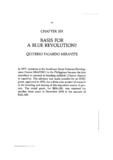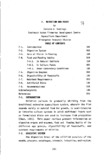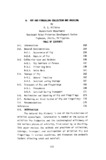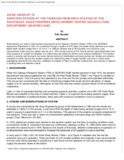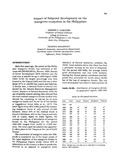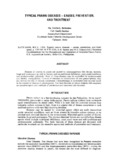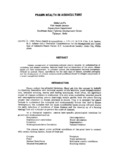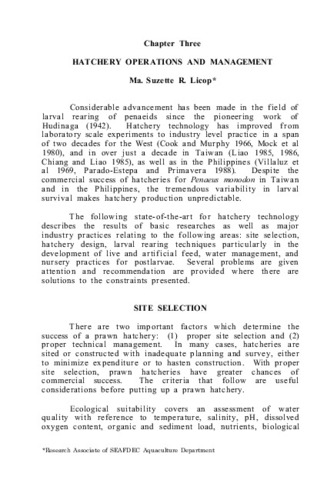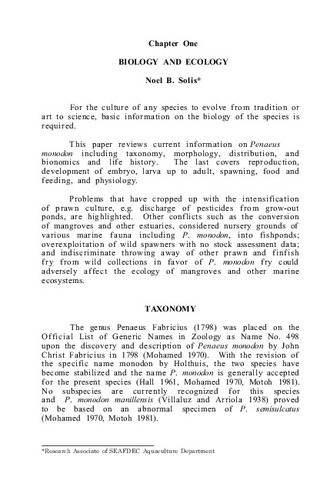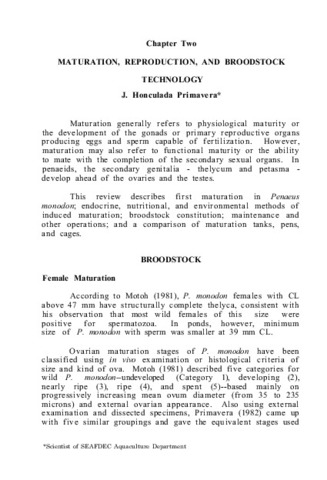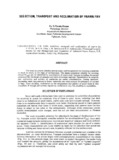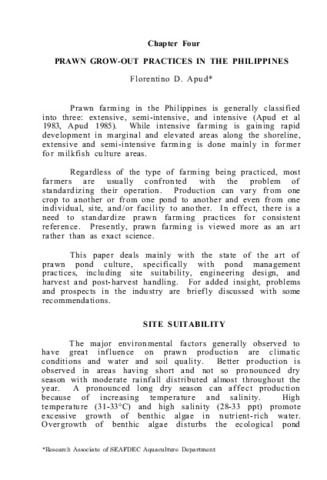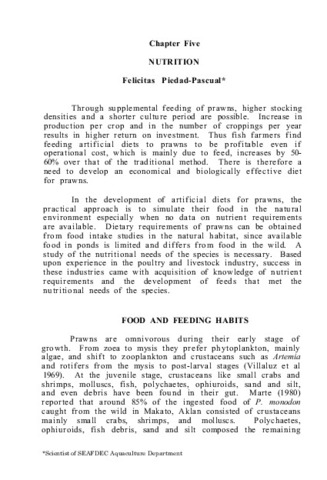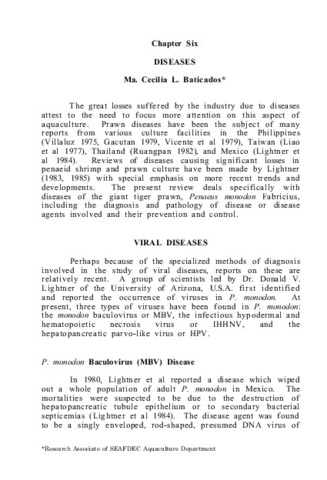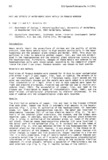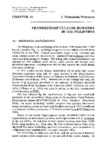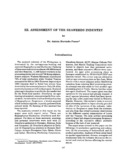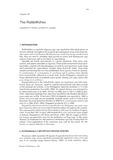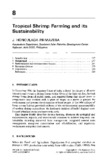Browsing AQD Books and Book Chapters by Issue Date
Now showing items 1-20 of 123
-
Basis for a blue revolution?
(International Development Research Centre, 1979)In 1977, scientists at the Southeast Asian Fisheries Development Centre (SEAFDEC) in the Philippines became the first anywhere to succeed in breeding milkfish (Chanos chanos) in captivity. The advance was made possible by ... -
Nutrition and feeds
(Oceanic Institute, 1986)Milkfish culture is gradually shifting from the traditional extensive aquaculture system, where in the fish depends mainly on natural food for growth, to semi=intensive or intensive culture systems in which additional ... -
Fry and fingerling collection and handling
(The Oceanic Institute, 1986)A review is made of methods and practices of collection, storage, transport and acclimation of milkfish (Chanos chanos ) fry and fingerlings in various countries. Factors affecting catch and survival are examined. -
Aeration system at the Tigbauan Research Station of the Southeast Asian Fisheries Development Center, Aquaculture Department (SEAFDEC/AQD)
(ASEAN/UNDP/FAO Regional Small Scale Coastal Fisheries Development Project, 1986)Roots blowers are used to meet aeration requirements at the Tigbauan Research Station (TRS) of the SEAFDEC Aquaculture Department in Iloilo. Air is delivered through a system of PVC pipes and plastic tubing attached to air ... -
Impact of fishpond management on the mangrove ecosystem in the Philippines
(Natural Resources Management Center and National Mangrove Committee, Ministry of Natural Resources, 1986)Fishpond development in the Philippines is discussed, examining resulting impacts on the mangrove ecosystems. Socio-economical implications and management measures are also considered. -
Typical prawn diseases - causes, prevention, and treatment
(U.P. Aquaculture Society, 1988)Diseases of prawn in ponds are caused by microorganisn like viruses, bacteria fungi and protozoans as well as factors such as nutritional deficiency, poor pond conditions and environmental pollutants. Most of these may be ... -
Prawn health in aquaculture
(U.P. Aquaculture Society, 1988)Disease management of intensively-cultured prawns requires an understanding of physiology and disease causation. Maladies result from an interaction of the prawn, disease agents and their environment. In intensive culture, ... -
Hatchery operations and management
(Aquaculture Department, SEAFDEC, 1988)A review is made of hatchery technology regarding the culture of Penaeus monodon , describing the results of research in the following areas: site selection; hatchery design; larval rearing techniques, particularly in the ... -
Biology and ecology
(Aquaculture Department, Southeast Asian Fisheries Development Center, 1988)A review is made of current information on Penaeus monodon covering various aspects, including taxonomy, morphology, distribution, bionomics and life history. Reproduction, embryonic development, larval stages, spawning, ... -
Maturation, reproduction, and broodstock technology
(Aquaculture Department, Southeast Asian Fisheries Development Center, 1988)Following a review of first maturation in Penaeus monodon , details are given of endocrine, nutritional and environmental methods of induced maturation used in aquaculture. Broodstock constitution and maintenance operations ... -
Selection, transport and acclimation of prawn fry
(U.P. Aquaculture Society, 1988)The most important criterion among many used by operators for choosing poostlarvae to stock in ponvds, is the stage of development. THe stages considered suitable for stocking (about PL20) can be identified by ... -
Prawn grow-out practices in the Philippines
(Aquaculture Department, Southeast Asian Fisheries Development Center, 1988)A review is made of the current situation regarding Penaeus monodon pond culture in the Philippines, examining in particular pond management practices, including site suitability, engineering design, and harvest and ... -
Nutrition
(Aquaculture Department, Southeast Asian Fisheries Development Center, 1988)A discussion is presented on dietary requirements of Penaeus monodon during culture operations. Food and feeding habits are described and nutrient requirements detailed, examining proteins and amino acids, lipids and fatty ... -
Diseases
(Aquaculture Department, Southeast Asian Fisheries Development Center, 1988)A review is made of diseases of cultured Penaeus monodon , examining the diagnosis and pathology of the disease or disease agents involved and their prevention and control. Both infectious (viral, bacterial, fungal and ... -
Fate and effects of water-borne heavy metals in Penaeus monodon
(European Aquaculture Society, 1991)Heavy metals impair the aquaculture of shrimps and the quality of shrimp products. Some heavy metals occur in high amounts particularly in the hepatopancreas and the antennal gland (Gibson and Barker, 1979). This study was ... -
Prawn/shrimp culture industry in the Philippines
(Elsevier, 1992)The Philippines is an archipelago of more than 7,100 islands with 17,460 km of coastline, including mangrove forests which covered about 450,000 ha in the 1920s. Coastal aquaculture began a few centuries ago when earthen ... -
Assessment of the seaweeds industry
(Department of Science and Technology and United Nations Development Programme, 1995) -
The rabbitfishes
(Elsevier, 1995) -
Aquaculture economics in Asia and the Pacific: A regional assessment
(Rome: FAO, 1997)A broad overview is given of research and information on aquaculture economics in Asia and the Pacific. Following a description of the general state of aquaculture in the region, an examination is made of the available ... -
Tropical shrimp farming and its sustainability
(Academic Press, 1998)In December 1996, the Supreme Court of India ordered the closure of all semi-intensive and intensive shrimp farms within 500 m of the high tide line, banned shrimp farms from all public lands, and required farms that closed ...

